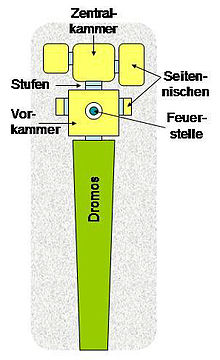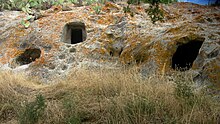Sas Concas
The Domus de Janas of Sas Concas are located in the province of Nuoro (NU) in Sardinia , on the right of the SS128 road in the direction of Oniferi , just after crossing under the "SS 131dir", across a small stream on a southern slope. In some of the 20 multi-room rock tombs there are upside-down symbols of the dead and ritual-magical bowls (cupules) on the walls .
Two of the tombs, the Tomba dell'Emiclieo and the Tomba Nuova Ovest, were the subject of study because of the schematic human petroglyphs. The similarity of the candelabra-shaped depictions of people with the statue menhirs by Laconi suggests that the figures go back to a use of some of the graves by members of the Monte Claro culture .
The stratigraphic data from the deposits in the Anticella of the Tomba Nuova Ovest (excavated by V. Santoni 1972) show the following sequence of material culture:
- Middle Bronze Age Nuragic Civilization I;
- Bonnanaro Culture ;
- Bell Beaker Culture ;
- Cultures of Abealzu-Filigosa .
An analogous continuity of use, with minor differences, is found in Santu Pedru near Alghero and in Molimentos near Benetutti. However, the horizon of Monte Claro is missing in the Tomba Nuova Ovest.
Looking at death as the counter-image of life results in the consequent depiction of the dead head down, as the inversion of a living person. In the same context, the upside-down clay vessels in the household items of the dead, as found in Santu Pedru , can be seen.
A woman standing upside down on the architrave of the Romanesque double apse church of San Michele Arcangelo in Siddi shows how deeply this symbolism is rooted in the Sardinian folklore and the paraphrase common in Sardinian parlance: a farrankas in susu (with the legs up) when speaking of the dead is.
Since the upside down Tanite symbol in the Phoenician-Punic tomb on Monte Sirai , like the petroglyphs of Sas Concas outside of Sardinia, has no contemporary counterparts, one must assume that it came from the hand of a Sardinian stonemason in Punic services, the ancient Sardinian ideas here realized.
See also
literature
- Alberto Moravetti, Carlo Tozzi et al. (Eds.): Guide archeologiche. Preistoria e Protostoria in Italia . 2: Sardegna . ABACO, Forlí 1995, pp. 115-121 ISBN 88-86712-01-4 .
Web links
Coordinates: 40 ° 17 ′ 29 ″ N , 9 ° 10 ′ 20 ″ E

